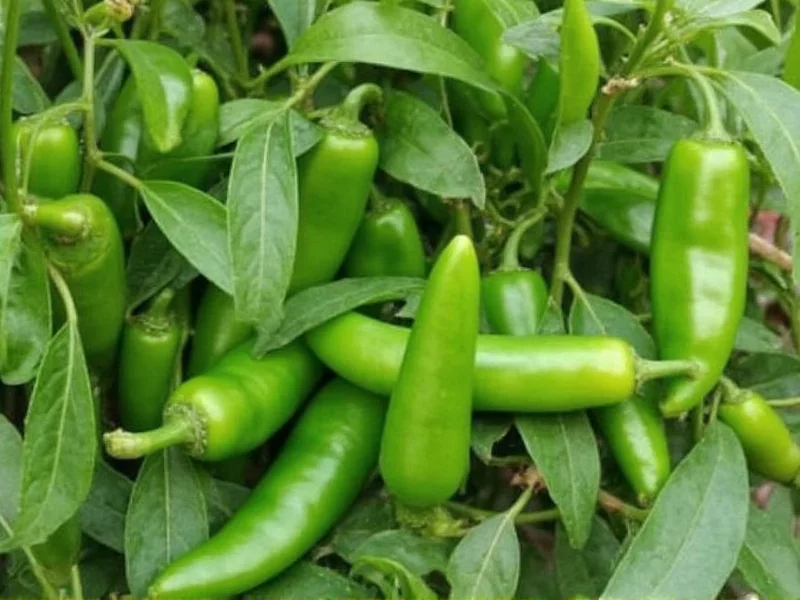No, serrano peppers and jalapeños are not the same. While both belong to the Capsicum annuum species, they are distinct chili pepper varieties with notable differences in heat level, appearance, flavor profile, and culinary applications. Serranos typically range from 10,000-23,000 Scoville Heat Units (SHU), making them significantly hotter than jalapeños, which measure 2,500-8,000 SHU.
Understanding the difference between serrano and jalapeno peppers is essential for home cooks and culinary enthusiasts who want to achieve the perfect balance of heat and flavor in their dishes. These two popular chili varieties often appear in Mexican and Southwestern cuisine, but substituting one for the other without understanding their characteristics can dramatically alter your recipe's outcome.
Physical Characteristics Comparison
When comparing serrano peppers vs jalapeno peppers side by side, several visual differences become apparent. Serrano peppers are typically smaller and straighter, measuring 1-3 inches in length with a smooth, firm skin. They maintain a consistent green color when immature, eventually ripening to red, orange, or yellow.
Jalapeños, by contrast, are larger (2-4 inches long) with a more bulbous shape and characteristic striations or stretch marks that appear as they mature. While both start green, jalapeños develop more pronounced color changes as they ripen, turning vibrant red, orange, or even purple.
| Characteristic | Serrano Peppers | Jalapeño Peppers |
|---|---|---|
| Size | 1-3 inches long, slender | 2-4 inches long, bulbous |
| Heat Level (SHU) | 10,000-23,000 | 2,500-8,000 |
| Flavor Profile | Grassy, bright, intense heat | Grassy, slightly sweet, moderate heat |
| Common Uses | Salsas, guacamole, pickled | Stuffed, pickled, sauces, nachos |
| Skin Texture | Smooth, firm | Waxy with stretch marks |
Heat Level Differences: Serrano Pepper vs Jalapeno
The most significant difference between these peppers is their heat intensity. Serranos are consistently hotter than jalapeños, typically measuring 2-3 times hotter on the Scoville scale. This heat difference becomes particularly important when substituting one for the other in recipes.
When determining which is hotter serrano or jalapeno, consider that serranos deliver a more immediate, intense heat that lingers longer, while jalapeños provide a milder, more gradual warmth. The heat in serranos is also more concentrated in the seeds and inner membranes, making proper handling crucial when preparing them.
Flavor Profiles and Culinary Applications
While both peppers share a grassy, vegetal base flavor, their taste profiles diverge significantly. Serrano peppers offer a brighter, more intense flavor with citrus notes that complement fresh salsas and guacamole. Their thinner walls make them ideal for raw applications where you want pronounced heat without overwhelming texture.
Jalapeños, with their thicker walls and slightly sweet undertones, perform better in cooked applications. They're the preferred choice for stuffed peppers, nacho toppings, and pickled preparations where their milder heat allows other flavors to shine through. The difference between serrano and jalapeno peppers becomes especially noticeable when used raw in dishes like pico de gallo.
Substitution Guidance: Can I Substitute Serrano for Jalapeno?
When considering whether serrano peppers substitute for jalapeno effectively, the answer depends on your heat tolerance and recipe requirements. If substituting serranos for jalapeños, use approximately half the amount to maintain similar heat levels. For example, if a recipe calls for two jalapeños, use one serrano pepper instead.
Conversely, when replacing serranos with jalapeños, you may need to increase the quantity by 50-100% to achieve comparable heat. However, keep in mind that this substitution will also alter the flavor profile, as jalapeños bring more sweetness and less brightness to dishes.
Growing Characteristics and Availability
For gardeners interested in growing these peppers, understanding serrano pepper characteristics versus jalapeño characteristics can help determine which variety suits your climate. Serranos thrive in warmer conditions and typically mature faster than jalapeños, making them suitable for shorter growing seasons.
Commercially, jalapeños are more widely available year-round in most grocery stores, while serranos may be seasonal or found primarily in specialty markets. This availability difference often influences which pepper home cooks choose when creating Mexican-inspired dishes.
Common Misconceptions Clarified
One prevalent misconception is that serrano peppers are simply immature jalapeños. This is incorrect—they are genetically distinct varieties. Another common misunderstanding is that color determines the pepper type; both can be green, red, orange, or yellow depending on ripeness.
When comparing serrano and jalapeno peppers, remember that heat levels can vary within each variety based on growing conditions, soil composition, and water availability. A particularly stressed jalapeño might approach the lower end of the serrano heat range, but this doesn't make them the same pepper.
Practical Usage Tips
For those wondering about using serrano peppers in recipes traditionally calling for jalapeños, consider these tips:
- Wear gloves when handling serranos to avoid skin irritation from capsaicin
- Remove seeds and membranes to reduce heat intensity when substituting
- Balance serrano's intense heat with dairy products like sour cream or cheese
- Use serranos in small quantities for hot sauces where intense heat is desired
- Choose jalapeños for stuffed pepper applications due to their larger size











 浙公网安备
33010002000092号
浙公网安备
33010002000092号 浙B2-20120091-4
浙B2-20120091-4